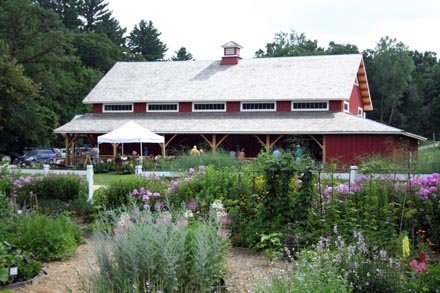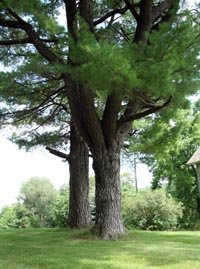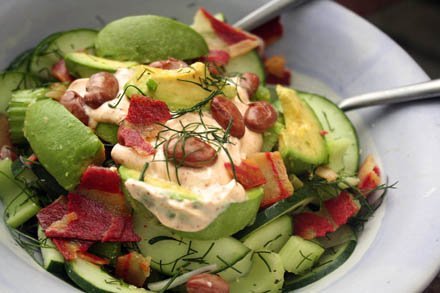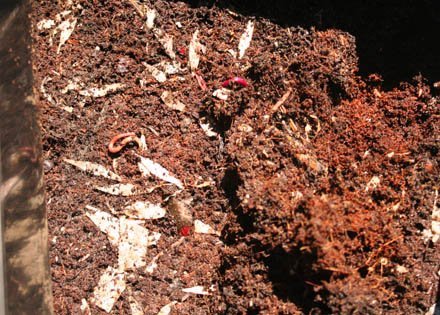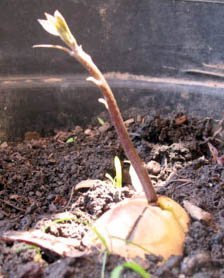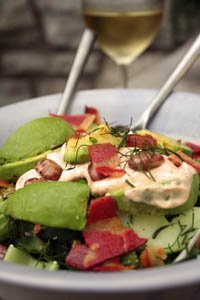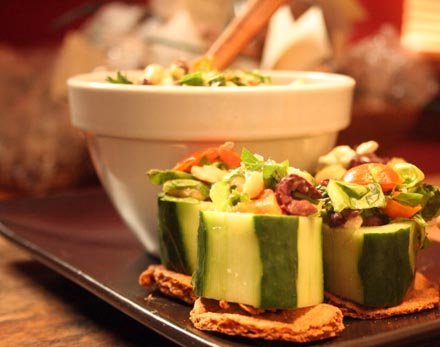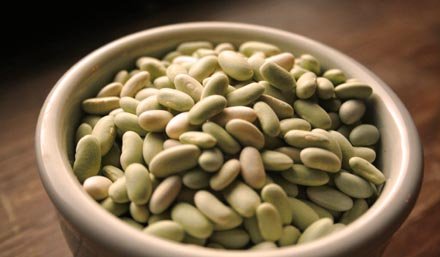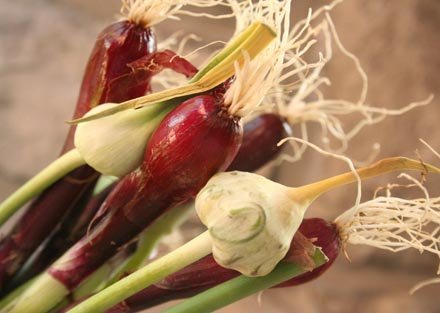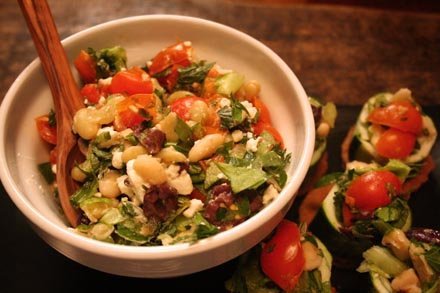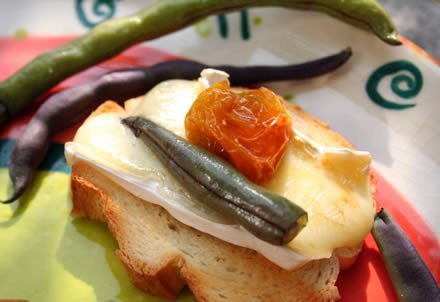
(Vegetarian)
We can’t claim that no one warned us.
We were in bed, Simon and I. I was lying in the humid darkness, chagrined to realize just how much of an urban girl I am. Simon was out cold.
We were in the cabin on the Seed Saver’s Exchange farm (see photos from last week). The pretty little bungalow, built in the 1870s, had been lovingly restored at some point. Still, it felt very much like the outdoors was coming right on in, and I laid there listening to each buzz and scrape and flutter of wings.

Then there was the odd humming noise. “I hear something!” I hissed, shaking Simon awake.
“We’re in a cabin in the middle of nowhere, you’re going to hear some things. Go to sleep.”
We repeated this routine a couple of times, Simon growing more exasperated with each go round. And exhaustion, that sticky intoxication that can’t be walked off, was pressing harder against me. I had finally given in and slipped into an uneasy unconsciousness when it rustled against me. Rapid, way too large, brushing against my shoulder.
“I feel something!” I shrieked, and flung the covers off. We both leapt out of the bed, landing hard on the floor. It was only after I had dashed across the room and hopped a little, unsure of where to go, that it occurred to me that I was running on my broken foot. (My orthopedic doctor doesn’t read this, I’m pretty sure, which is why I share this part).
When the lamp light washed over the room, it revealed a tiny bat, lying on the floor at the head of the bed. We had been warned about this. The cabin’s chimney has a tiny opening, through which bats have been known to enter.
I had apparently flung the bat against the wall when I tossed off the covers. My heart sank. Brown, unmoving, its wings mostly folded in again, I might have mistaken it for a small clump of earth. Looking at it, I felt a tenderness and sorrow that took my breath away.
It felt wrong, to think of moving it. “We’ll take it outside in the morning,” Simon said.
But in the morning, the bat was gone. I was jubilant at its resurrection, and giddy with the realization that I hadn’t killed it at all. Of course, this meant that on night two it woke from sleep and echolocated around the room again. On the second night we had help. Janisse Ray, one of my favorite nature writers and a woman who slam-brakes for frogs, was staying with us. When the bat emerged from its sleeping spot sometime past moon-up, the three of us (Janisse and Simon, mostly – I am on crutches still) managed to herd it into a trash can and set it loose under the sky. If its protestation was any indication of its lifeforce, that bat is tearing up Decorah as I type.
This story, of course, has nothing to do with recipes or food. That’s coming. But first I want to share a bit more about the Seed Saver’s Exchange convention.

I mentioned last week in passing that I’d spent some time talking with Lynne Rosetto Kasper. She was the keynote speaker for the convention, and told us how it was only through her travels across Italy that she was able to appreciate the food she had grown up with. It was these experiences of eating and writing and living in a foreign land that set her on the road to the locavore she is today.
We also befriended Leslie Allen, who is one of the bloggers on Lynne’s Locavore Nation website. Along with 14 others throughout the U.S., Leslie has committed to a year of consuming 80% of her diet in locally grown (100-mile radius) foods. Leslie lives in Reno though and gets to count Napa…
I spent some time talking with Deborah Madison as well. She has a quiet presence which belies the astonishing transformation she has effected on food and cooking over the last 20 years. Deborah was one of the first to celebrate the simplicity and diversity of market-fresh food. She is also that rare breed, a woman of the written word who can, nevertheless, stand up in front of a crowd and talk in a way that seems effortlessly engaging and entertaining.
I met Dave Cavagnaro, who is credited with taking many of the original photos for the Seed Savers Exchange catalogs. Dave grows almost all of what he and his family eats. When the temperatures start to dip, as they are inclined to do in his part of Iowa, he digs up his veggie-laden plants and hauls them into a root cellar. The just-above freezing temperatures arrest the plant growth and preserve the perfectly ripe fruits just so, blessing his family with fresh, local produce when blizzards rage outside. Dave also keeps dwarf citrus trees and enjoys year-round limes, lemons and kumquats.
I could go on and on about the inspired and inspiring, dedicated and energetic people I met. The fact that there are this many people tells me something important: the locavore movement is about to become more than a movement.
I’m convinced, in fact, that it’s about to become the way we eat. Lately the New York Times has taken to framing the eat-local mentality as elitist and passing. I think this is wrong. I suspect that “local” will soon become “necessary”, perhaps “only”, as energy costs soar higher than indeterminate tomatoes in July, and as the dollar exchange rate slumps in the dirt. And, environmentally speaking, it just makes sense.
If we are discovering sustainability out of necessity, I think we’ll be surprised to discover the joy, diversity and freedom that this shift will bring us as well.
(Scroll past the recipe for more photos from the Seed Saver’s Exchange farm and convention).
The recipe
In the name of eating local then, here’s a recipe that is about 87% local. The tomatoes, heirloom sungolds whose seeds were saved from a pint we bought last summer from Brett Palmier of Biver Creek Farms, and the beans came from our backyard. The bread, a sourdough, was made by Viviano’s, a local, independent Italian grocer (I can’t promise that the wheat itself was local). The cheese, I have to admit, came from France.
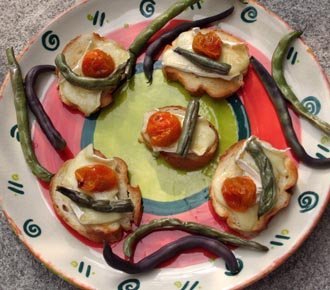
The cheese, Brie, was sent to me by Ile de France, an American importer of French cheese. I talk more about this soft-ripened cheese on the products review page, but for the purposes of this recipe, let me say that the creaminess of this Brie works beautifully with the acidity of the tomatoes. Like a good Brie, this one gets softy and nearly liquid at room temperature; put it in the oven and it bubbles and browns without changing its flavor too much.
I’m very excited about the beans. They’re the first of my 12 or so varieties to present themselves as ready to eat. Grown to be eaten fresh, the vivacious Royalty Purple Pod is hard to ignore when it’s mature. In just 56 days, this heirloom’s jewel-toned pods contrast brightly against the green garden foliage.
I tried roasting them on high heat for just 8 minutes, in the hopes that they’d keep this lovely hue. Alas, they faded to green, but just-cooked like this, they are crispy and fresh and only mildly starchy.
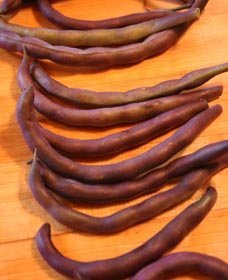
This is a simple, unadorned dish. You could toss on some tarragon, if you have it, but I wanted to taste the individual flavors of each ingredient, so I seasoned only with olive oil and salt.
Roasted tomatoes royalty purple podded beans and Brie on Italian bread
Large handful of Royalty Purple Podded beans (can use fresh green beans)
20 Sungold cherry tomatoes (can use red cherry tomatoes)
2 teaspoons olive oil
Coarse salt for seasoning
1 loaf crusty Italian bread, cut into ½ inch thick rounds
1 tablespoon butter or margarine
5 ounces Brie, or you can use a local goat cheese, thinly sliced
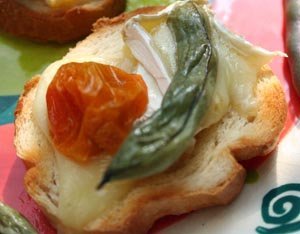
Get everything ready before you begin so that the oven is on for the shortest amount of time possible. If done efficiently, the oven can do its work in 12 minutes.
Wash fresh beans and snap off the woody stems. In a bowl, mix the beans and tomatoes with the olive oil. Toss well to coat them with oil, then sprinkle with the coarse salt. Arrnage on a jelly roll baking sheet lined with aluminum foil.
Butter one side of each of the bread rounds. Place, buttered side up, on another baking tray.
Heat oven to 400 degrees. Place beans and tomatoes on top rack and bread rounds on lower rack. Let cook for 8 minutes, until beans are roasted and tomatoes have burst.
Remove tomatoes and beans from oven. Also remove bread rounds. Turn bread rounds, buttered side down. On the unbuttered side, place one slice of Brie, one tomato and one bean. Add tarragon if desired.
Slide toasts back into the oven and cook just until Brie has begun to bubble, about 4 minutes. Serve immediately.
And now for a few more photos from the Seed Saver’s Exchange convention. Here we have the SSE Visitor’s Center, where they keep a dizzying array of books and seeds. Then there’s another view of the edible landscape that sits between the visitor’s center and the barn; a photo of the two old trees that frame — and predate — the 1870s cabin on the hill. And one more of the cabin, just because it’s so pretty.
